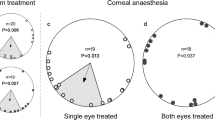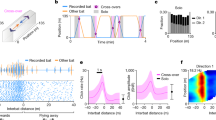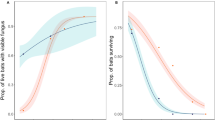Abstract
Bats famously orientate at night by echolocation1, but this works over only a short range, and little is known about how they navigate over longer distances2. Here we show that the homing behaviour of Eptesicus fuscus, known as the big brown bat, can be altered by artificially shifting the Earth's magnetic field, indicating that these bats rely on a magnetic compass to return to their home roost. This finding adds to the impressive array of sensory abilities possessed by this animal for navigation in the dark.
This is a preview of subscription content, access via your institution
Access options
Subscribe to this journal
Receive 51 print issues and online access
199,00 € per year
only 3,90 € per issue
Buy this article
- Purchase on SpringerLink
- Instant access to full article PDF
Prices may be subject to local taxes which are calculated during checkout

Similar content being viewed by others
References
Simmons, J. A. et al. in Hearing by Bats (eds Popper, A. N. & Fay, R. R.) 146–190 (Springer, London, 1995).
Neuweiler, G. The Biology of Bats (Oxford University Press, New York, 2000).
Berthold, P. Bird Migration: A General Survey (Oxford University Press, Oxford, 2001).
Michener, M. C. & Walcott, C. J. Exp. Biol. 47, 99–131 (1967).
Cochran, W. W., Mouritsen, H. & Wikelski, M. Science 304, 405–408 (2004).
Muheim, R., Moore, F. R. & Phillips, J. B. J. Exp. Biol. 209, 2–17 (2006).
Bonadonna, F., Holland, R., Dall'Antonia, L., Guilford, T. & Benvenuti, S. J. Exp. Biol. 203, 207–212 (2000).
Wikelski, M. et al. Biol. Lett. 2, 325–329 (2006).
Author information
Authors and Affiliations
Corresponding author
Ethics declarations
Competing interests
The authors declare no competing financial interests.
Supplementary information
Supplementary information
(PDF 44 kb)
Rights and permissions
About this article
Cite this article
Holland, R., Thorup, K., Vonhof, M. et al. Bat orientation using Earth's magnetic field. Nature 444, 702 (2006). https://doi.org/10.1038/444702a
Received:
Accepted:
Published:
Issue Date:
DOI: https://doi.org/10.1038/444702a
This article is cited by
-
Sensitivity threshold of avian magnetic compass to oscillating magnetic field is species-specific
Behavioral Ecology and Sociobiology (2023)
-
The Relationship between the Magnetic Compass and Vision in Birds: In Search of Receptor Cells
Neuroscience and Behavioral Physiology (2023)
-
An artificial neural network explains how bats might use vision for navigation
Communications Biology (2022)
-
The discovery of the use of magnetic navigational information
Journal of Comparative Physiology A (2022)
-
Why is it so difficult to study magnetic compass orientation in murine rodents?
Journal of Comparative Physiology A (2022)



